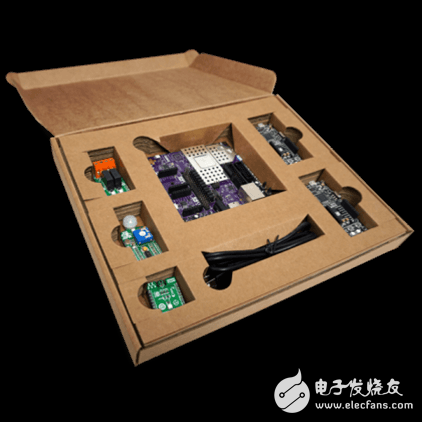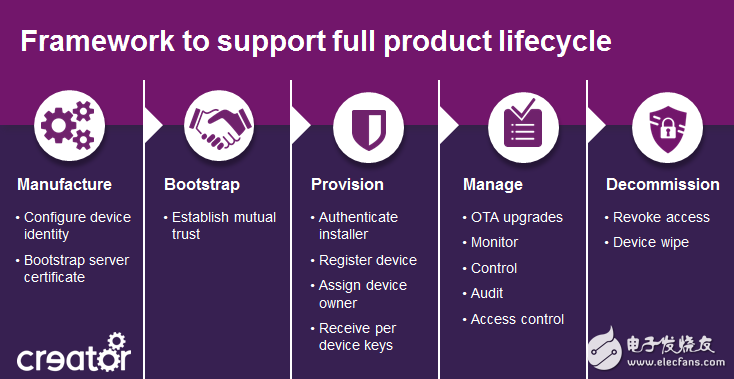This article explains why boards developed based on the user community are not ideal for the Internet of Things (IoT) platform, why developers need more feature-rich systems to implement efficient scalability solutions.
Anyone who delve into the Internet of Things (IoT) system can confirm that finding a scalable, open source IoT framework and connecting your devices to cloud services reliably and securely may be more challenging than we think. Sex, the most important thing is to meet your own business needs rather than the choice.
Many community boards are now able to connect to various cloud service systems in a one-to-one manner. But if you look further, you will find that such boards are usually inadequate in terms of security protection, or there is no scalable software framework to help users reduce development costs, which means we have to use more devices without causing bandwidth costs beyond control. However, such typical base boards generally do not provide device management functions (control panel).

Many community boards, such as the Raspberry Pi, Beaglebone, and other open source boards, are often associated with Internet of Things (IoT)-related vocabulary, but have little to do with building Internet of Things (IoT) wireless applications and security. On the surface, these boards are cheap and make you feel that the development of the Internet of Things (IoT) system is simple.
However, when your needs are not just to send a few bytes of temperature data or turn on/off the lights of the Christmas tree, but to seek to develop a larger Internet of Things (IoT) system, you will find that these boards are really limited. Of course, community boards also have their own applications and are convenient, but can these primary functions be used to build future industrial and commercial Internet of Things (IoT) platforms? Can such a board resist DoS attacks? How to bridge multiple wireless connection standards and what kind of development software development framework can you provide? Can you give users flexibility and effective control costs?
Commercial Internet of Things (IoT) systems must be scalable to keep the operating environment secure and provide a comprehensive open source development framework that supports device management and strong interoperability. So where can we find such a development system?

Try the Creator IoT-in-a-box development kit, which provides a comprehensive hardware and software system and an end-to-end open source Internet of Things (IoT) development framework for business needs where it is quickly integrated into the Internet of Things ( IoT) solutions are also brought to market.
Creator Ci40 IoT integrated development kit and open source Internet of Things (IoT) development framework provide users with a scalable development platform, developers can control, monitor, manage a lot of equipment (24 days a day), to meet the industry "Predictive maintenance" and standard requirements for efficiency. If you're looking for a development kit to develop a professional-grade IoT solution, this development kit is perfect for you.

In addition to simply connecting a single device to a mobile phone, businesses, organizations, and businesses need a way to deploy and extend the IoT hardware system and maintain good interoperability between the hardware system and existing devices, whether it is a new device. Still old equipment.
To meet the needs of such systems, the Creator Ci40 IoT Hardware Development Kit also provides an open source IoT development framework based on the Mobile Open Alliance LWM2M standard for device management and interaction with other IoT devices through the IPSO framework.

LWM2M device features
â— Lightweight
â— Node scalability
â— Scalability framework supports efficient use of bandwidth and power consumption
â— Standardized device management such as firmware management, loading, security, and access control
â— Service enabled
â— Support local and cellular network work

IPSO specification
Smart object internet protocol
â— IPSO provides a common object model for standardization of sensors or actuators
â— IoT devices can read data directly from sensors and update IPSO objects
â— The actuator will also observe the IPSO object
â— IoT devices have read or control status
â— Temperature value
â— Battery capacity
â— Relay position
â— Attachment version
Often commercial applications do not like to use dedicated high-cost solutions, which may lead companies to a dead end, so it is important to find an IoT solution based on open source standards. Open source means that many companies can collaborate with each other and be able to quickly get help from the community and, if possible, even lead the development of the entire open source standard. Of course, this is also the benefit of using the Creator Ci40 IoT Development Kit and the Creator IoT Development Framework, an open source project that we can download for free from Github.
The Creator Ci40 Development Kit provides developers with the opportunity to experiment and implement a secure operating environment with a dedicated Infineon TPM device integrated on the board. Of course, this board also supports a variety of wireless communication standards, such as Wi-Fi, Bluetooth, 802.15.4 and other hardware modules are soldered on a hardware platform. If you want to use other wireless communication standards, the Creator Ci40 IoT motherboard card also provides an expandable interface, developers can add other wireless communication modules. For example, you may be interested in Lora network technology, then you can buy some off-the-shelf modules directly from third parties and plug them directly into the extension interface provided by Ci40.

The development kit is based on IoT scalability and integrates dual-core, multi-threaded, MIPS InterApTIv CPUs running at 550MHz. It also supports porting the Linux operating system, while also integrating the microship PIC32MZ MIPS MCU running at 80MHz.
MAINTEX Car Parking Automatic Gate Barrier & Boom Barrier Gate: 0.5s to 4s Lifting or Falling Speed, APP Set All Parameters, 30V Low-voltage Brushless DC Motor, Long Life & Strong Anti-interference.
If you want barrier gate, boom barrier, boom gate, gate barrier, automatic gate barrier, barrier gate price, car parking gate, boom barrier gate or Other Products, please contact us to Customize for you.
barrier gate,boom barrier,boom gate,gate barrier,automatic gate barrier,barrier gate price,car parking gate,boom barrier gate
Shenzhen Maintex Intelligent Control Co., Ltd. , https://www.maintexmotor.com